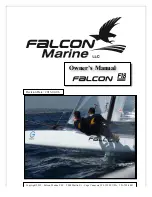
J/145
OWNER
GUIDE
42
•
It is best to keep fuel tank 1/2 full (diesel #2) to avoid debris intake and air locks.
Turning Engine Off
•
Place throttle lever in idle position (vertical).
•
Let engine cool down 5-10 minutes.
•
Push engine stop button on engine instrument panel until engine stops.
•
When audible alarm sounds, turn key off. DO NOT use key to stop engine. Do not stop engine with
decompression lever except in extreme emergency. If decompression lever is used to stop engine,
fuel will spray out and accumulate on top of pistons, creating danger of explosion the next time engine
is started.
Fueling the Diesel Tanks
When preparing to take on fuel, the following safety precautions should be followed at all times: Properly
secure the boat to the dock using bow, stern and spring lines.
•
Shut off all equipment: Engine, Battery Switch, Radios, Lights, Etc.
•
Remove fuel fill plug and clean threads of both plug and deck plate carefully so no dirt falls into filler
opening. Place the fuel hose nozzle into the fill pipe.
•
Fill slowly. DO NOT OVERFILL. Marine fuel expands with an increase in temperature. Thus, fill only
to 95% capacity. If you cannot see the fuel pump, ask the attendant or a crew member to call out the
total gallons.
•
If fuel tank is overfilled, fuel will leak out the tank vent located on the transom. This spillage should be
cleaned up immediately.
•
After fueling, replace fill plate and wash up any spillage. Go below deck and check for fumes or
leakage. Check bilge.
IF EITHER FUMES OR LIQUID FUEL ARE PRESENT, CORRECT THE
SITUATION BEFORE PROCEEDING.
Open all hatches and ports to facilitate ventilation.
•
Only after you are totally satisfied that no potentially dangerous condition exists, leave the fuel dock.
Be considerate of fellow yachtsmen.
•
In the event of a serious spillage,
STOP FUELING IMMEDIATELY
. Replace fill plate, notify attendant
so he may warn others and wash down thoroughly all traces of fuel or source of fumes.
Engine Maintenance
Check the engine, batteries, and engine mounts once a month. Ensure the engine is fastened securely to
the engine mount frames and look for any problems, such as fuel or oil spillage. If you need help, consult
a professional marine mechanic or a Yanmar licensed repair mechanic.
Run the engine frequently and at occasional high speeds, even if it is not in gear. One reason why
sailboat engines may burn out within a few years is that they are run infrequently and lubricating oil is not
thoroughly and evenly distributed on all moving parts. Be sure to check oil and coolant levels often. If you
have any doubts about the purity of the fuel you are buying, use a strainer to filter out water and dirt. If you
experience problems, contact your nearest Yanmar Service Representative.
Summary of Contents for J/145
Page 1: ...J 145 Owner Guide COPYRIGHT J BOATS INC 2001...
Page 11: ...J 145 OWNER GUIDE 12 Diagrams Layouts Schematics Mainsheet TravelerDiagram...
Page 12: ...J 145 OWNER GUIDE 13 HalyardLayout...
Page 13: ...J 145 OWNER GUIDE 14 ReefingSystemDiagram...
Page 14: ...J 145 OWNER GUIDE 15 CheckstaySystem...
Page 15: ...J 145 OWNER GUIDE 16 Jib GenoaHardwareLayout...
Page 16: ...J 145 OWNER GUIDE 17 DeckHardwareLayout...
Page 17: ...J 145 OWNER GUIDE 18 Engine ExhaustSystemLayout...
Page 18: ...J 145 OWNER GUIDE 19 FuelSystemLayout...
Page 19: ...J 145 OWNER GUIDE 20 Thru HullLocations...
Page 20: ...J 145 OWNER GUIDE 21 FreshWaterSystemLayout...
Page 21: ...J 145 OWNER GUIDE 22 HeadSumpLayout...
Page 22: ...J 145 OWNER GUIDE 23 BilgePumpLayout...
Page 23: ...J 145 OWNER GUIDE 24 HeadPlumbingSystem...
Page 24: ...J 145 OWNER GUIDE 25 MainAC DCDistributionPanel...
Page 25: ...J 145 OWNER GUIDE 26 AC DCComponentLayout...
Page 28: ...J 145 OWNER GUIDE 29 DCFanLayout...
Page 29: ...J 145 OWNER GUIDE 30 ACLayoutwithForwardHeadOnly...
Page 30: ...J 145 OWNER GUIDE 31 ACLayoutwithAftHeadOnly...
Page 31: ...J 145 OWNER GUIDE 32 ACLayoutwithBothForward AftHeads...
Page 32: ...J 145 OWNER GUIDE 33 OptionalInverterWiring...
Page 33: ...J 145 OWNER GUIDE 34 PropaneSystemLayout...
Page 34: ...J 145 OWNER GUIDE 35 BondingSystem...
Page 35: ...J 145 OWNER GUIDE 36 RudderShaftDetail...
Page 36: ...J 145 OWNER GUIDE 37 KeelInstallationInstructions...











































